Search intent, sometimes also referred to as user intent, is the reasoning behind users searching different queries into search engines. Lots has been talked about search intent in the past 5 years especially, but there is still so much we all have to learn about it.
In this article, we will talk about what search intent is, why it's important for SEOs to understand, and the differerent types of search intents there are out there.
We will also talk about how to figure out what the search intent is behind different queries, whether search intent can change over time, and how you can optimise pages for different search intents.

What is Search Intent?
Search intent, also referred to in some circles as user intent, is the end goal a user has in mind when they type a query into a search engine. There are different types of search intent and this includes informational, commercial, navigational, and transactional queries.
Search intent is, essentially, the phrase we use when we are talking about the psychology of a search query. When we search something in a search engine, we need something. We might want some information, we might want a different website, we might want to find a business partner. The reasoning could be anything, but there is always a reason behind what we are searching.
Search intent is the way to describe this.
Why is Search Intent Important for SEOs?
Search intent is incredibly important for SEO for one particular, but crucial, reason... If we are not properly matching the intent behind a keyword we want to rank for, we are not going to rank for that keyword.
Let's use an example.
I may want to cook dinner for myself and my partner tonight, but I want the entire process to take less than two hours. I know we both love lasagne, but I need to find a recipe for this. So I type "quick lasagne recipe" into Google and find this result:
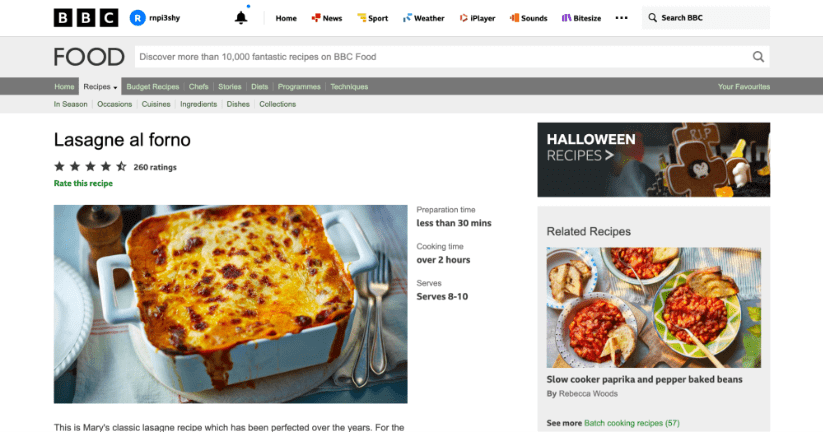
This is great, but there is a problem. The cooking time is over 2 hours, and I do not have this kind of time. Because of this, I click off this particular website and I head back to the SERP. I then find this result:
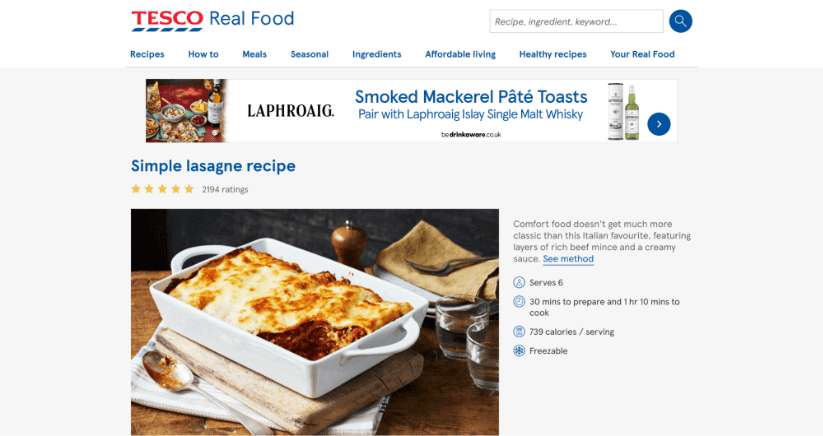
Brilliant. The cooking time on this is 30 minutes to prepare and 1 hour & 10 minutes to cook, less than 2 hours in total. Because of this, I stay on this website, scroll around as I follow the recipe and maybe click some other links on the page.
Search engines like Google, Bing, and Yahoo, see this activity. They see that I clicked off the other website and onto this site, so they know that I have had a better experience on this website than the other. They may, because of this, choose to rank this example from Tesco over the example from the BBC.
Obviously, this is just one particular example and there are many, many others. But this does highlight why matching the intent of each and every query you rank for is important!
If you are not matching the query, you may not rank as high as you can for your chosen query.
The Different Types of Search Intent
Almost no two searches have exactly the same intent. Because of this, marketers over time have come up with four different terms to describe different intents. Navigational, informational, commercial and transactional.
Below, we'll give you more information on each intent type and an example for each.
Navigational Intent
When we talk about navigational intent, we are referring to the act of using a search engine to find a specific website or page on a website. Rather than typing in the URL into a browser's search bar, they will use the search engine and type a specific query in order to find the page they are looking for.
For example:
I want to get to Reddit's login page, and I type "Reddit Login" into Google in order to get me to their login page.
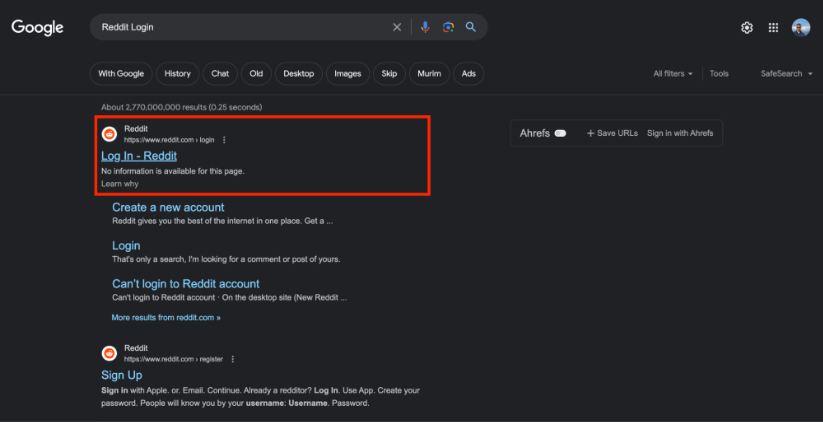
This takes me exactly to the page I want to get to.

This is quite a simple intent, and not something we need to put too much thought into. Navigational searches are very direct. A user isn't likely to change their mind on a navigational query as they are looking to get to a very specific place.
Informational Intent
When I conduct a search that has an informational intent, I am looking for additional information about something. There are, actually, different types of informational searches.
Some are very quick and "one way" such as finding the age of a celebrity, or finding the time in a different country. However, some are a little more complex, and require more input from marketers at the content creation stage.
Here's an example of one of these more complex informational searches:
We at SEOTesting are about to launch a new product into the market, and I have been tasked with creating a promotional video for the new product. I don't know how to do this, but I want to learn more. So I type "how to create a product promotion video" into Google:
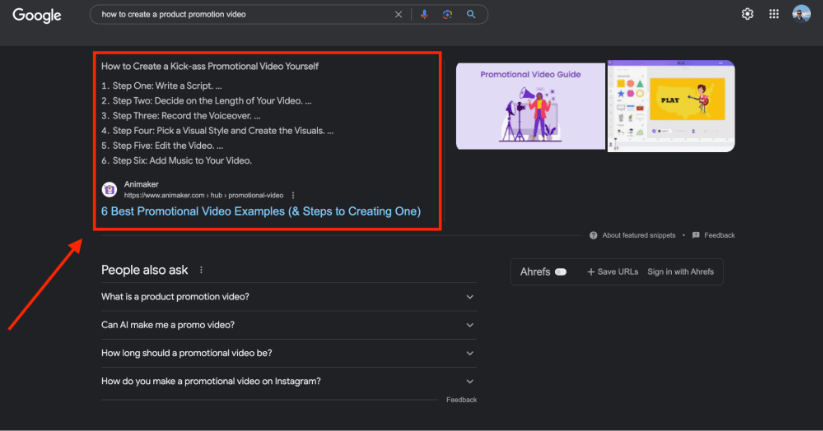
This example looks good. According to the meta title, the article is going to give me 6 promotion video examples and steps on how to create one for myself. This sounds like exactly what I need. So I'm going to click on the article and give it a read.
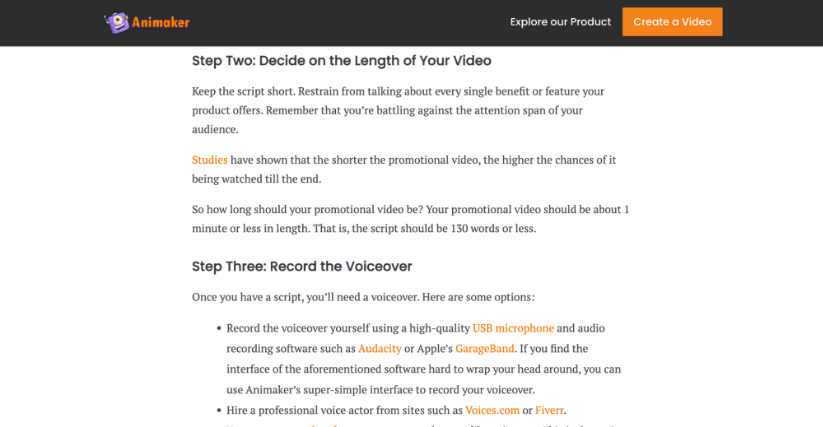
There we go, this article does have exactly what I need! Steps on how to create a product promotion video which I can now go ahead and do for myself after following the advice within this article.
This article has perfectly matched the informational intent I had.
Commercial Intent
Commercial intent is the umbrella term for someone who is searching in order to do more research before making any sort of purchasing decision. This can go both ways. It can be research about products, services, etc. Or it can be research about companies themselves.
Here's an example of commercial intent in action:
I am looking for a new coffee machine for my home. I don't want a large espresso machine, but a coffee pod machine should work just fine. I am based in the UK, so obviously I want all the products to be available in the UK should I decide to purchase. Because of all this, I search "best coffee pod machines uk" into Google and find this website from BBC Good Food:

When reading through this particular article, I can see that there are sections that I can jump quickly to including:
- The best coffee pod machines at a glance.
- The best coffee pod machines to buy in 2023.
- How the author chose the best coffee pod machines.
- How the author tested each coffee pod machine in the list.
Each option within the final list has been reviewed thoroughly, fairly and the reviewer gives an honest opinion at the end of each section.
There is also a section on how to choose the best coffee pod machine.
Thanks to all this information, I won't need to visit another web page. This page meets my commercial search intent, and I may now move on to transactional intent with my next search!
Transactional Intent
When I have done all the research necessary, I may then move into the purchasing stage of the buying funnel. To accomplish this next stage in my journey, I will need to search with transactional intent.
Here's an example of searching with transactional intent:
I need a new pair of trainers. I like the Lacoste brand. Therefore I want to buy a pair of white Lacoste trainers. So, to do this, I will search "buy white lacoste trainers" on Google. I can then complete my purchase by either clicking on the shopping ads that appear within the SERP itself:
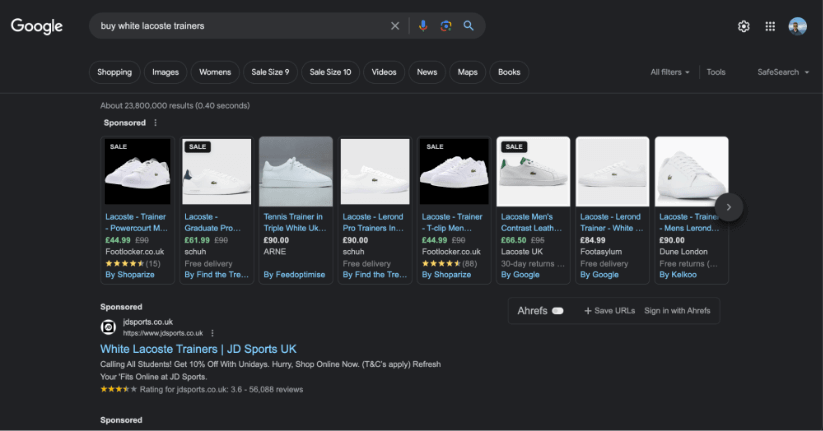
Or I could scroll down and buy the pair of trainers I want through one of the many websites that have appeared in the SERPs organically, like House of Fraser:
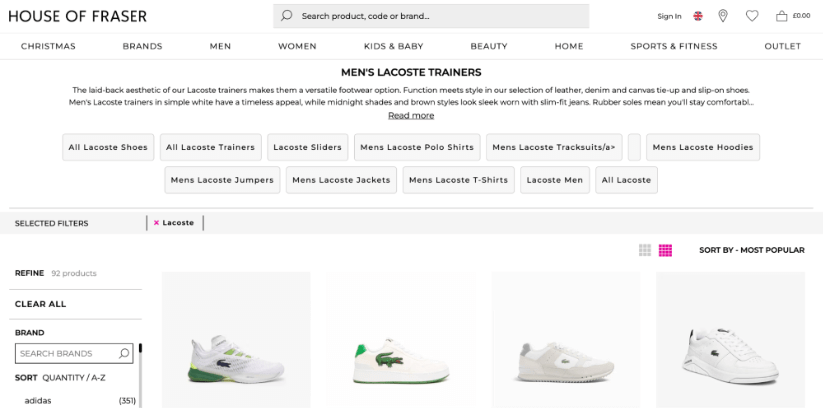
An important note:
Transactional searches do not always apply to people wanting to purchase something, they can apply to completing any transaction in general. This means I'd still be searching with transactional intent if I wanted to:
- Sign-up to a newsletter.
- Download a free app or game.
- Register as a user for a website.
How to Determine the Search Intent of Different Queries
Finding the intent of search queries is an absolute necessity of effective SEO, as well as just helping you get a basic understanding of user needs. By recognising the purpose behind a search, you can tailor your content and strategies to better align with the expectations of those users searching. This'll lead to improved user satisfaction and, potentially, higher search rankings overall.

Look at the Top Pages on the SERP
Perhaps the first thing you should do is look at the top-ranking pages for a specific query. If the majority of the search results are PLPs or other ecommerce listings, it's a massive indicator of transactional intent. On the other hand, if the results consist of mainly blog posts, articles, or any other educational resources like ebooks or podcasts, it's likely the users are wanting more informational content.
Analyse a Search's Keywords and Modifiers
You should also make sure you analyse the keywords within the queries themselves. Specific, long-tail, keywords often provide a clearer picture of a user's end goal compared to broader, head, terms. For example, a search for "buy blue running shoes" has a clear transactional intent behind it. Whereas a query like "what is the history of Nike the company" leans towards informational intent, which would indicate the user seeks more knowledge.
Use Google's SERP Features
You can also make use of Google's own features to help find the intent behind different keywords! The "People Also Ask" sections and the "related searches" section within the SERPs themselves are great examples. These features can offer more insight into common questions or topics associated with particular queries, giving more information as to what users might be seeking. For example, if a lot of related searches revolve around buying guides or reviews, it's a hint towards a commercial or transactional intent.
Understand User Behaviour
Lastly, having a deep understanding of your target audience's behaviour and their preferences is essential. Regularly reviewing your website's analytics, tracking user interactions, and paying attention to questions you're asked frequently can provide a wealth of information! As you gather more data and refine your understanding of search patterns, you will be better equipped to predict and cater to the specific needs and intentions of your users. This will ensure a more seamless and satisfying customer experience.
How to Optimise Pages for Different Search Intents
In this section, we'll explore how you can optimise pages for different search intents, focussing specifically on the new content creation phase as well as the content optimisation phase.

New Content Creation
Before you begin crafting your content, it is essential to conduct thorough keyword analysis and research in order to identify terms and phrases your target audience uses. This research will encompass primary keywords, long-tail keywords, and related terms that add any additional context that is needed. By using tools like Google Keyword Planner, Semrush, Ahrefs and Google itself, you can find insights into these search terms which will allow you to tailor your content to address specific questions and needs.
You also need to make sure that the structure and quality of your content is user-friendly and that it aligns with search intent. For informational searches, clear headings, images, and concise explanations are crucial. Transactional searches, in contrast, benefit from clear calls-to-action and detailed information about products. It's vital to produce comprehensive, authoritative, and trustworthy content that anticipates any potential questions and queries. Using images and videos can further improve the user experience of your content and keep users engaged.
Beyond the core content, attention to your on-page SEO elements is also important. Crafting compelling meta titles and descriptions, effectively using header tags, and not forgetting to optimise your alt text are all just a few strategies to consider. Internal links can guide users to explore your site further, whilst external links to reputable sources can reinforce your content's credibility. Moreover, with many searches conducted on mobile devices, ensuring your content is mobile-friendly is a non-negotiable aspect of matching search intent.
Content Optimisation
Understanding and optimising for different search intents is crucial during any content optimisation phase.
First, you should categorise search intents into your primary types: Informational, transactional, navigational, and commercial. Analyse user behaviour on your site, using tools like Google Analytics, as this can provide insights into what drives your visitors.
Once you have identified the intent of people landing on your pages, you can work to optimise your content for this intent. This links back to what we said above during the content creation process! If you find that people landing on your pages have the intent of learning, then crafting useful information is key. If the intent is more transactional, ensure you are giving as much product information as possible and utilise clear call to actions within your content.
Lastly, regularly review and update your content! Search intents can evolve, and staying up to date with these changes ensures your content remains relevant. By addressing the specific needs and behaviours associated with each search intent, you will be able to enhance the experience people are having on your page, which will then lead to an increase in user engagement, and will boost yout site's chances of ranking higher in search engine results.
All query-based reports in SEOTesting.com now have search intent highlighting. This will help you pick out valuable queries to target and work with.
SEOTesting.com has three predefined types of search intent, with the following keywords added by default:
Informational search intent: what,who,when,where,which,why,how
Transactional search intent: buy,order,purchase,cheap,price,discount
Commercial search intent: best,top,review,comparison,compare,vs,versus
You can extend this list of keywords by visiting the website settings. There is also a custom search intent field that is free to use for any list of keywords specific to the site's niche or sector.
By highlighting these search intent queries you can easily scan a query report and pick out valuable keywords to investigate and work with. This could involve creating new content, content expansion on existing pages, running click through rate experiments, or simply tracking the query in the SEOTesting.com rank tracker.
Can Search Intent Change Over Time?
Yes! We explored this a little in the section above, but it is absolutely possible for search intents to change over time.
Search intents are influenced by societal, technological, and personal shifts. Cultural evolutions and technological advancements, such as the rise of smartphones or voice assistants, reshape how (and why) people search. Current events, seasons, and emerging trends also play a role, leading to many natural fluctuations in search patterns based on time or happenings.
Market dynamics and product availability can also have an impact on altering search behaviour. For example, the introduction of a groundbreaking new product (like the Apple Vision Pro) or a sudden market shortage might prompt users to seek alternatives or gather more information. On a personal level, an individual's life stages, such as moving from university to a full-time job, can also influence their objectives with search.
A Note on Core Algorithm Updates
Search engines themselves also play a part. As they update their algorithms to improve user experience, the way people search and their expectations from search results can evolve. Ensuring you are staying up to date with these changes is crucial for content creators and digital marketers to remain relevant.
In fact, one of the main reasons Core Updates are implemented is because of changing search intents!
Frequently Asked Questions
We'll now answer some of the web's most searched questions about search intent!
What is Search Intent in SEO?
Search intent in SEO refers to the underlying reason or purpose behind a user's search query. It's the reason why someone types something into a search engine and presses 'search'.
Broadly categorised, search intent can be informational, transactional, navigational, or commercial.
Understanding search intent is vital for creating content that meets users' needs and improves chances of ranking higher in the SERPs.
What is Search Intent, with an Example?
Search intent is the motivation behind a user's search query. For example, the query of "how to bake a chocolate cake" has a clearly informational intent, as the user is seeking knowledge or instructions on baking a chocolate cake!
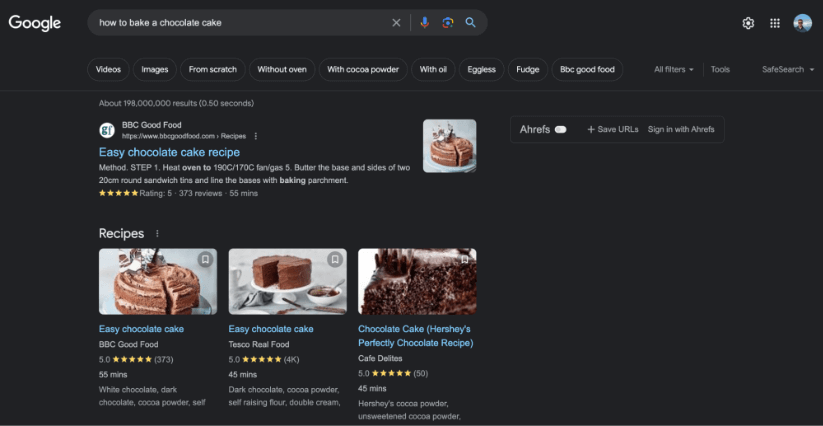
What are the "Three Cs" of Search Intent?
The "three Cs" of search intent are:
- Content
- Context
- Customer
They represent the type of content users seek, the context in which they are searching, and the customer's stage in the buying journey. Understanding these elements helps tailor content to meet user needs and improve SEO performance.
What are the Four Types of Search Intent?
The four types of search intent are:
- Informational (someone is seeking knowledge).
- Transactional (someone has an intent to purchase a product or service).
- Navigational (someone is interested in finding a specific website).
- Commercial (someone is comparing products or services).
To Conclude
Search intent, or the motive behind a user's search query, plays a pivotal role in shaping effective SEO strategies. By understanding whether users are looking for information, aiming to make a purchase, navigating to a specific site, or comparing products, content creators and digital marketers can align their content more closely with users' needs. As the digital landscape and user behaviors evolve, it becomes even more crucial to stay attuned to shifts in search intent. By continuously monitoring, adjusting, and refining content to match these intents, businesses can ensure better user satisfaction, higher engagement, and improved search engine rankings.
Are you looking for a tool that will help make SEO testing easier for your business? Have you changed a page on your website to better match search intent and want to see the SEO impact of that change? SEOTesting is the tool for you. We're currently running a 14-day free trial, with no credit card required, so sign-up today.

